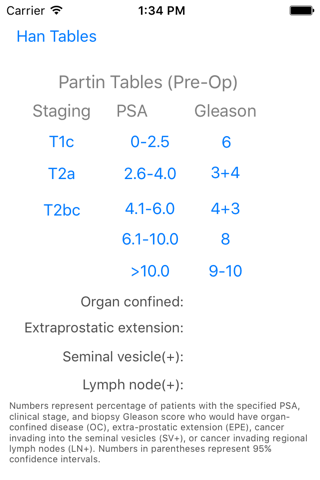
The Partin Tables for Urologists
What is the probability of prostate cancer prior to surgery?
The “Partin Tables” were originially developed by urologists Alan W. Partin, M.D., Ph.D., and Patrick C. Walsh, M.D. based upon accumulated data from hundreds of patients who had been treated for prostate cancer. The tables correlate the three things that were known about a man’s disease -- PSA Level, Gleason Score, and estimated clinical stage – to help men and their doctors predict the definitive Pathological Stage (determined after surgery, when a pathologist examines the removed prostate for the presence of cancer) and best course of on-going treatment. This application accepts as input the PSA, TNM, and Gleason Score and immediately returns the probabilities for:
•Organ Confinement
•Extraprostatic Extension
•Seminal Vesicle Invasion
•Lymph Node Invasion
The Han Tables for Urologists
What is the probability of prostate cancer recurring after surgery?
The “Han Tables” were developed by urologists, Misop Han, M.D., Alan W. Partin, M.D., Ph.D., and Patrick C. Walsh, M.D.. The Han tables were designed to predict the probability of the first evidence of recurrence (detectable PSA level) following surgery. Like the Partin Table Lookup described above, the Han Tables correlate the three common factors known about a man’s prostate cancer – PSA, TNM, and clinical stage – in order to predict the probability of recurrence up to 10 years following surgery. This application accepts as input the PSA, TNM, and Gleason Score and immediately returns the recurrence probabilities for years 3, 5, 7, and 10 following surgery.



